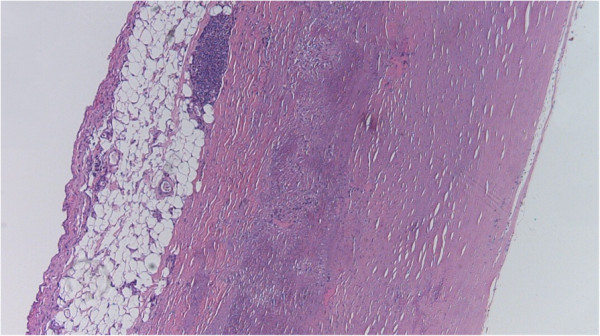Playlist
Show Playlist
Hide Playlist
Atherosclerosis and Wound Healing
-
Slides Pathogenesis of Plaque Formation.pdf
-
Reference List Pathology.pdf
-
Download Lecture Overview
00:01 In essence, we have recapitulated normal wound healing. 00:05 It's just in the vessel wall. 00:07 So in a previous session or sessions, we have talked about wound healing in any tissue and involves initial entry, inflammatory cell recruitment, angiogenesis, smooth muscle cell migration and proliferation, matrix synthesis, matrix remodeling. 00:26 That's a healing wound. 00:28 Same thing here except that it's occurring in a vessel wall. 00:32 And it's with an intact and affiliate over the surface. 00:34 It's just a very dysfunctional endothelial because of all the known risk factors. 00:40 So, revisiting this very briefly, we start off with endothelial cell dysfunction due to all those things in the Grey box with all the bullet points, all those will cause endothelial cell dysfunction. 00:54 That along with cytokines, inflammatory cytokines will drive the production of adhesion molecules that can recruit and allow the movement across the endothelium of monocytes. 01:06 Those monocytes get into the sub endothelial intima, become macrophages, become activated. 01:13 And now we have vascular permeability with low density lipoprotein becoming oxidized LDL, that drives macrophages into a frenzy so they generate a lot more cytokines. 01:24 And as they take up that lipid through their scavenger receptors become typical classical foam cells that we see in an early fatty streak. 01:35 Over time, as they elaborate more cytokines, they drive greater endothelial cell dysfunction, activation, and also the recruitment and activation of the underlying medial smooth muscle cells. 01:48 As those migrate in, we then get accumulation of those, we get necrosis, we get accumulated fat, and we have a full blown atherosclerotic plaque. 02:02 Smooth muscle cells have proliferated, matrix has been synthesized. 02:07 And we have the accumulation of the extracellular lipid and necrotic debris. 02:12 Okay, so where are the smooth muscle cells, and traditionally, smooth muscle cells are coming from the media, from the smooth muscle media. 02:22 But we also now know that they're coming from non medial sources. 02:27 And just very briefly, so you have our initial endothelial cell injury and dysfunction. 02:33 We recruit in inflammatory cells, the macrophages that will make interferon gamma and interferon gamma driven chemo kinds, and those will recruit smooth muscle cells, not only from the underlying media, but it turns out there are circulating precursors, mesenchymal stem cells that are in the circulation, that can also contribute to this process. 02:56 And they are adherent through the usual adhesion molecules, and driven by chemokines to get into that informal space. 03:04 So they can be from both sources. 03:07 So to reiterate, this now, I think, the third time, so it must be really important. 03:12 Atherosclerosis is wound healing in a vessel with an intact endothelium. 03:18 There's injury. 03:19 There's inflammatory cell recruitment, both innate and adaptive immunity. 03:25 They elaborate cytokines and growth factors that drive angiogenesis, that drives cellular proliferation, including smooth muscle cells, that lay down more matrix. 03:36 And as a result, we get our atheromatous plaque. 03:41 With that, we've kind of described how we got there. 03:43 And now in subsequent sessions, we'll describe what's the outcome.
About the Lecture
The lecture Atherosclerosis and Wound Healing by Richard Mitchell, MD, PhD is from the course Atherosclerosis.
Included Quiz Questions
The process of atherosclerotic plaque formation is similar to...
- ...wound healing in a vessel wall.
- ...angiogenesis and neovascularisation.
- ...tissue injury and matrix remodeling.
- ...scar formation.
- ...extracellular matrix (ECM) deposition.
What substance recruits smooth muscle cells to form intimal plaques?
- Interferon-gamma (IFNγ)
- Toxins
- Oxidized LDL
- Necrotic debris
- Cholesterol
Customer reviews
5,0 of 5 stars
| 5 Stars |
|
5 |
| 4 Stars |
|
0 |
| 3 Stars |
|
0 |
| 2 Stars |
|
0 |
| 1 Star |
|
0 |




